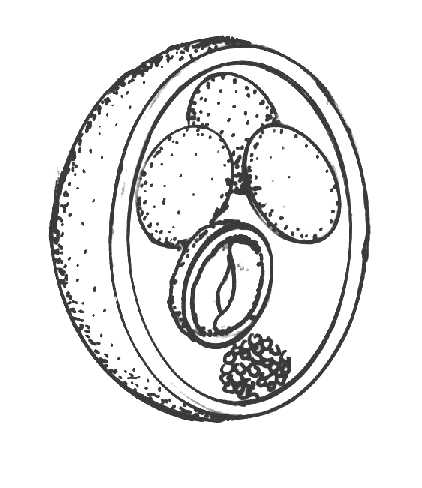Eimeria tarsii Duszynski, Wilson,
Upton and Levine, 1999.
Type host: Tarsius syrichta (Linnaeus,
1758) (syn. T. carbonarius), Philippine tarsier.
Other hosts: None reported to date.
Type locality: ASIA: Philippines, Mindanao.
Geographic distribution: ASIA: Philippines,
Mindanao.

Description of oocyst: Oocyst shape: oval; number
of walls: 1 (in line
drawing); wall characteristics: smooth, "thin" (in line drawing); L x W: 15-18 x
10-13; M: absent (in line drawing); OR: present; OR characteristics: spheroidal mass
of small and large granules (in line drawing); PG: absent. Distinctive features of
oocyst: small size with large OR.
Description of sporocysts and sporozoites:
Sporocyst shape: ellipsoid; SB:
absent; SSB: absent; PSB absent; SR: absent; SP: elongate, with one end wider than
the other, lying lengthwise head to tail in sporocyst. Distinctive features of the
sporocyst: lack of SB, SR and RB.
Prevalence: 1/3 (33%).
Sporulation: Exogenous. Oocysts sporulated in 96
hrs, but the temperature is unknown.
Prepatent period: Unknown.
Patent period: Oocysts were passed for at least 15
days.
Site of Infection: Unknown. Oocysts recovered from
feces.
Material deposited: None.
Remarks: This species was first seen when Osman
Hill et al. (1952) reported the natural history and endoparasites of three T.
carbonarius (2 females, 1 male)
received by the Gardens of the Zoological Society of London in March, 1948. Only the
male was found to pass oocysts, which they described; they also provided three line
drawings (their Figs. 7-10), the latter, of a sporulated oocyst. Although their
description of the sporulated oocysts is marginal by today's standards, when taken
with the line drawings, we believe there is sufficient information to distinguish
this form from other described species found in prosimian genera to date. Osman Hill
et al. (1952) said the oocysts were "oval," but illustrated them as ellipsoid.
Reference: Osman Hill et al. (1952).

